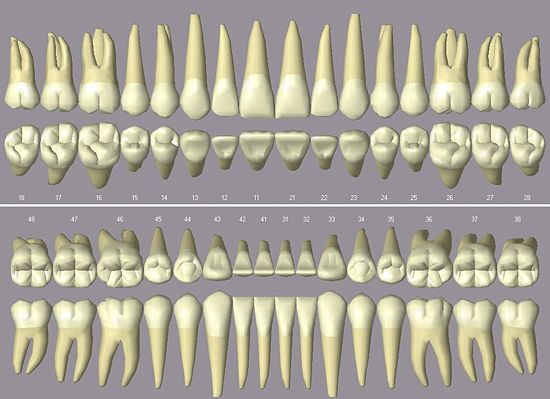Molar (tooth)

A molar or molar ( Dens molaris , plural Dentes molares ; from Latin molaris , millstone) is a large molar tooth . Molars are primarily used to grind food that has previously been bitten off by the incisors .
Permanent dentition - milk dentition
In humans, a distinction is made between the molars of the permanent teeth and the molars in the deciduous teeth, the deciduous molars . Each quadrant contains three permanent molars, so the permanent set of teeth contains a total of twelve molars. In the deciduous dentition, each quadrant contains two deciduous molars. In the FDI tooth scheme , the permanent molars are given the tooth designations 6, 7 and 8, which are preceded by the quadrant number, e.g. the second upper right permanent molar has the tooth designation 17. The deciduous molars are given the tooth designation 4 and 5. The first lower right deciduous molar has the deciduous molar the tooth designation 84. Molars are large, strong teeth with pronounced cusps ( tubercles ) and dimples ( fissures ). The first upper permanent molar, more rarely the second, often has an accessory cusp, the tuberculum carabelli .
dentition
As the first permanent tooth, the first molar (6th) breaks through behind the last milk tooth around the age of six (i.e. without a milk tooth falling out beforehand). It is therefore also called the six-year molar . The second molar (7th) erupts around the age of twelve as the last for the time being. The third molar does not normally appear until adulthood (around 18 to 25 years of age) and is therefore also called a wisdom tooth . In about 50% of people, the wisdom teeth are not created or displaced and / or retained .
Because the six-year molars usually erupt before the deciduous incisors are lost, laypeople often regard them as delayed deciduous teeth. As such, they are then neglected in dental care (“They fail”) and are often damaged very early on.
The molars are popularly called "incremental teeth" because there were no milk teeth in their position before. In contrast, the replacement teeth (1st to 5th) cause the deciduous tooth to fail at the respective position when they erupt . In rare cases, a baby tooth is not ejected by a replacement tooth. The milk tooth then remains in the dentition, it persists. This can either be a retained and / or displaced tooth or a non-abutment of the permanent tooth. Neither of these occurs in molars.
In rare cases, there is also a ninth tooth that breaks through as the fourth molar.
Tooth roots
The number of tooth roots , root canals and cusps are shown in the following table, although deviations are possible.
| teeth | Number of tooth roots | Number of root canals | Number of humps |
|---|---|---|---|
| 16, 26 | 3 | 3 (41.1%) 4 (56.5%) 5 (2.4%) |
4th |
| 17, 27 | 3 | 3 4 |
4th |
| 18, 28 | variable | variable | variable |
| 36, 46 | 2 | 2 (6.7%) 3 (64.4%) 4 (28.9%) |
5 |
| 37, 47 | 2 | 2 3 4 |
4th |
| 38, 48 | variable | variable | variable |
The human dentition (schematic):
In the upper jaw , the human molars have three or more roots . One very strong on the palate side ( palatal root) and two smaller ones on the cheek side ( vestibular ). Of these, in turn, one root is at the front ( mesial ) and the other at the back ( distal ). The two vestibular roots are correctly referred to as the mesio-vestibular root and the disto-vestibular root. In everyday practice, however, the distal, mesial and palatal roots are simply referred to briefly. There is at least one root canal per root. Mesio-vestibular roots sometimes have two canals.
In the lower jaw , the molars have two roots. One root is mesial (front) and one root is distal (back). There is at least one root canal per root. However, in the majority of cases, the mesial root has two canals - one canal is vestibular (on the cheek side) and the other lingual (on the tongue side).
The roots of the wisdom teeth can be extremely variable both in their number (1 to 5) and in their shape (for example stunted or barbed), as can the number of root canals. This can lead to problems with tooth extractions and unsolvable problems with root canal treatments.
When using a surgical microscope, the success rate in finding additional root canals is significantly increased.
See also
Individual evidence
- ↑ Teeth, R. Mieg, Haug Verlag, 4th edition. Reprinted 2006, ISBN 978-3-8304-2227-3
- ^ Gert-Horst Schuhmacher, Anatomie, Textbook and Atlas, 2nd edition 1991, Barth-Verlag. ISBN 3-335-00264-4 .
- ^ John I. Ingle, Leif K. Bakland, Endodontics, Williams & Wilkins, Philadelphia, 4th Sub edition (1994), ISBN 0-683-04310-2 .
- ↑ JR Strube, M. Stern, Curriculum Prothetik, Volume I, Quintessenz Verlag, 2011, pp. 32–33. ISBN 3-86867-026-2 .




